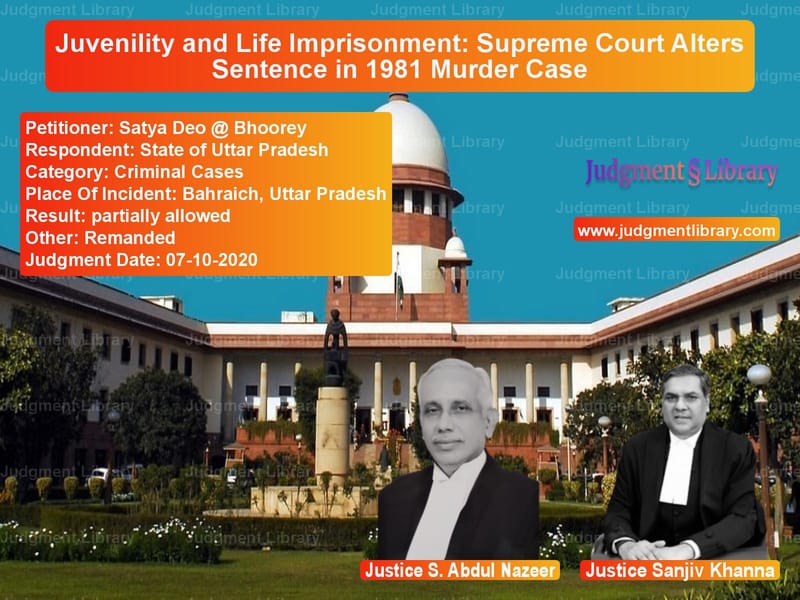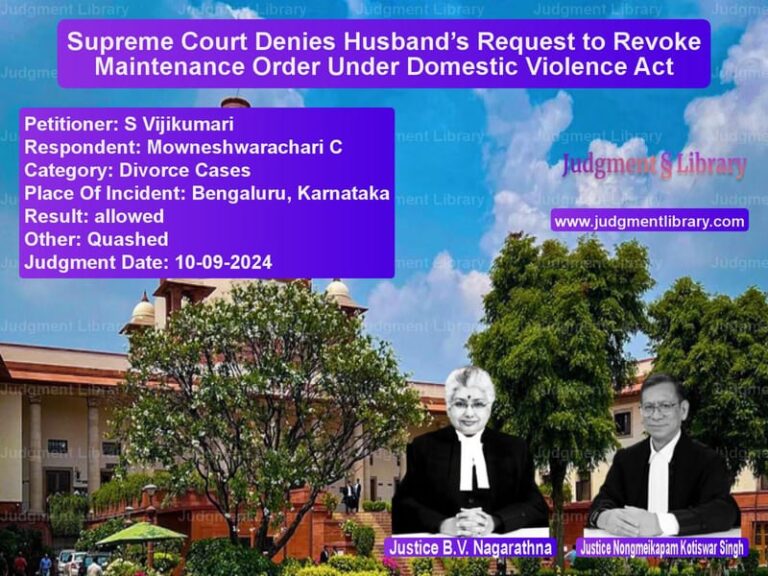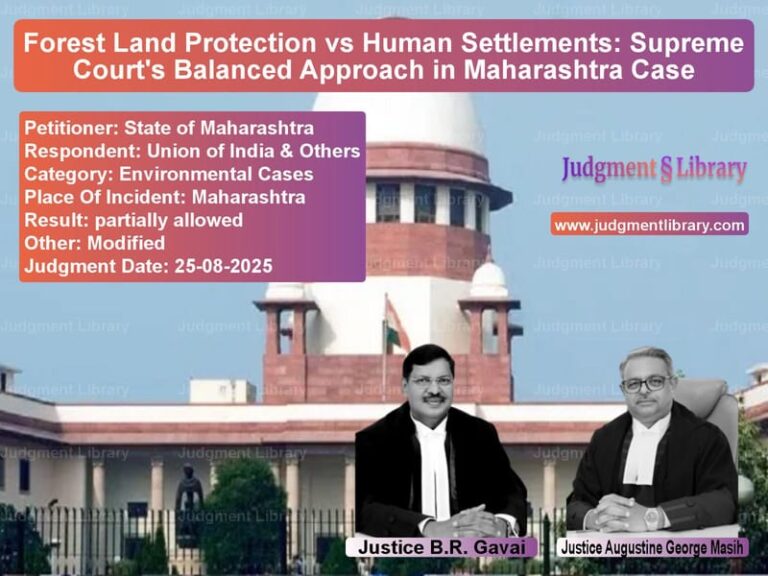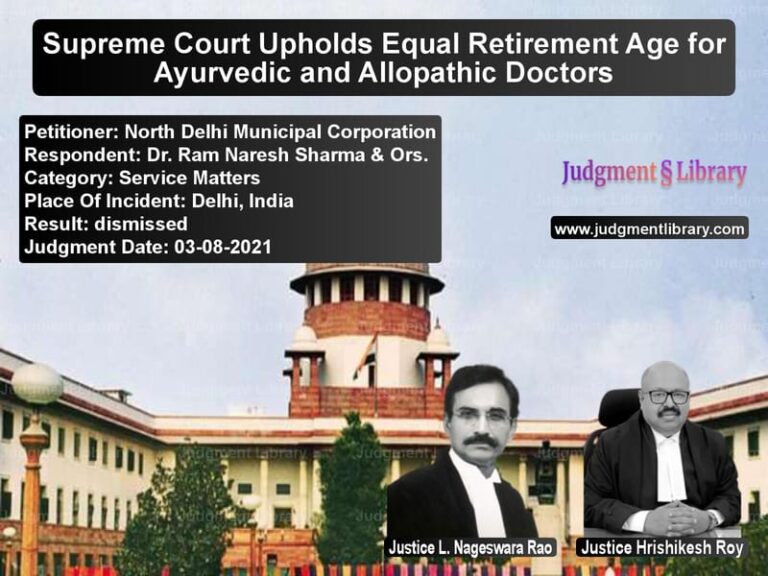Juvenility and Life Imprisonment: Supreme Court Alters Sentence in 1981 Murder Case
The case of Satya Deo @ Bhoorey vs. State of Uttar Pradesh revolves around the legal principle of juvenility and its retrospective application in a murder case dating back to 1981. The Supreme Court was tasked with determining whether the appellant, who was a juvenile at the time of the crime, was entitled to relief under the Juvenile Justice (Care and Protection of Children) Act, 2000. The judgment also examined how juvenility should be considered even after conviction and sentencing.
Background of the Case
The case stems from an FIR registered on 11.12.1981 under Section 302 read with Section 34 of the Indian Penal Code (IPC) at Gilaula Police Station, Bahraich, Uttar Pradesh. The trial court convicted the appellant, Satya Deo @ Bhoorey, along with two other co-accused and sentenced them to life imprisonment. The Allahabad High Court upheld their conviction in 2018. However, while dismissing the appeals of his co-accused, the Supreme Court issued a notice in the case of Satya Deo solely on the issue of juvenility.
Determination of Juvenility
The Supreme Court directed the First Additional District and Sessions Judge, Bahraich, to conduct an inquiry into the appellant’s age at the time of the crime. The inquiry established that:
- Satya Deo’s date of birth was 15.04.1965.
- On the date of the crime (11.12.1981), he was 16 years, 7 months, and 26 days old.
- His age was verified through school records, including a transfer certificate and an admission register from the primary school he attended.
Despite these findings, the lower court held that since he was over 16 years old, he was not a juvenile under the Juvenile Justice Act, 1986. However, the Supreme Court noted that the definition of juvenility changed with the Juvenile Justice (Care and Protection of Children) Act, 2000, which classifies anyone below 18 years as a juvenile.
Key Legal Issues
1. Retrospective Application of the Juvenile Justice Act
The Supreme Court relied on several landmark rulings to hold that the Juvenile Justice Act, 2000, applies retrospectively in cases where the accused was below 18 years at the time of the offense, even if they were tried and convicted under the previous law.
It referred to the Constitution Bench ruling in Pratap Singh v. State of Jharkhand, which clarified that:
“The reckoning date for determining the age of the juvenile is the date of the offense and not the date when he is produced before the authority or court.”
2. Special Provisions for Pending Cases
Section 20 of the Juvenile Justice Act, 2000, provides that in pending cases where a person was below 18 years at the time of the offense, the court must apply the provisions of the Act even if the person is no longer a juvenile at the time of trial.
The Court observed:
“Juvenility can be raised at any stage of the proceedings, even after final disposal of the case.”
3. Modification of Sentence
Since juveniles cannot be sentenced to life imprisonment, the Supreme Court ruled that the appellant should not continue serving his sentence. Instead, his case was referred to the Juvenile Justice Board for appropriate orders.
The Court emphasized:
“The sentence imposed on a juvenile under the Juvenile Justice Act cannot exceed three years, regardless of the gravity of the offense.”
Final Verdict
The Supreme Court upheld the conviction of Satya Deo but set aside the life sentence. It directed the jail authorities to produce him before the Juvenile Justice Board within seven days, which would pass an appropriate order regarding his custody or release.
Key Takeaways
- The Juvenile Justice Act, 2000, applies retrospectively to cases where the accused was below 18 at the time of the offense.
- Juvenility can be raised at any stage of legal proceedings, including after conviction.
- Even in murder cases, a juvenile cannot be sentenced to life imprisonment.
- Convictions remain valid, but sentencing must comply with the Juvenile Justice Act.
- The Juvenile Justice Board will determine the appropriate order in such cases.
This judgment reinforces the principle that juvenility must be recognized even in long-pending cases, ensuring that legal protections for minors are upheld regardless of the crime committed.
Petitioner Name: Satya Deo @ Bhoorey.Respondent Name: State of Uttar Pradesh.Judgment By: Justice S. Abdul Nazeer, Justice Sanjiv Khanna.Place Of Incident: Bahraich, Uttar Pradesh.Judgment Date: 07-10-2020.
Don’t miss out on the full details! Download the complete judgment in PDF format below and gain valuable insights instantly!
Download Judgment: Satya Deo @ Bhoorey vs State of Uttar Prade Supreme Court of India Judgment Dated 07-10-2020.pdf
Direct Downlaod Judgment: Direct downlaod this Judgment
See all petitions in Juvenile Justice
See all petitions in Bail and Anticipatory Bail
See all petitions in Judgment by S. Abdul Nazeer
See all petitions in Judgment by Sanjiv Khanna
See all petitions in partially allowed
See all petitions in Remanded
See all petitions in supreme court of India judgments October 2020
See all petitions in 2020 judgments
See all posts in Criminal Cases Category
See all allowed petitions in Criminal Cases Category
See all Dismissed petitions in Criminal Cases Category
See all partially allowed petitions in Criminal Cases Category







